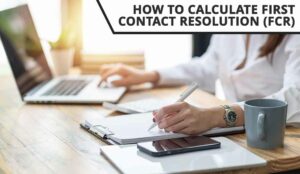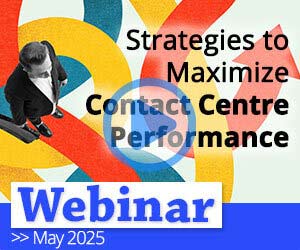There’s a lot to be gained from measuring First Contact Resolution (FCR) – first and foremost. This includes increased customer satisfaction and fewer repeat calls.
However, it can be hard to shift gear if your contact centre culture prizes Average Handling Time (AHT) above all else.
So, here is some advice from our reader panel on boosting performance with First Contact Resolution at the helm.
How to Improve Performance with an FCR First Strategy
Change Your Agents’ Conversations for the Better
It’s not enough to just start measuring First Contact Resolution and expect improvements overnight. You’ll likely find your agents need to tweak their approach to help your FCR-first strategy succeed. Here are some ideas to help shift the dial in the right direction.
1. Encourage Every Caller to Raise All Questions
A good way to practise true First Contact Resolution (FCR) is to encourage callers to raise all the questions they have.
The agent can then deal with them all before wrapping up the call.
We call it “tipping the bucket” and it’s a good habit for agents to get into.
Contributed by: James

2. Pre-Empt Onboarding Issues With New Customers
You don’t know what you don’t know. That’s why First Contact Resolution can be particularly challenging when it comes to handling new customers.
One way to help keep everything to one call – and to avoid skewing your metrics – is for agents to pre-empt any additional information the customer may need to know.
Making sure agents are briefed in a thorough and consistent approach on what to go over on those initial calls is critical. It can also help to signpost new customers to self-serve options too.
Contributed by: Susan
3. Call the Customer Back if You Need To
It’s all-too-easy – especially with a chatty customer – for the agent to realize something has been missed AFTER hanging up the phone. The most important thing here is that they feel safe to admit their mistake and call them back.
This saves future contacts, as the customer won’t need to call back and waste even more time starting over with another agent later on.
Contributed by: James
4. Check for Understanding
It’s best practice for agents to proactively manage customers’ expectations and check they understand what’s happening next.
Everything from explaining realistic timeframes to letting them know that additional information will be arriving in a letter can prevent the customer calling back later on. All of these add up to have a positive impact on your First Contact Resolution metrics.
Contributed by: Aaron
5. Don’t Just Say “No”
Don’t just say “no” and wrap up the call. If something isn’t possible, it can help if agents try and explain the reasons behind the decision and point the customer in the direction of alternative options or resources to help.
If a customer feels dismissed, they may not believe the agent was being honest or helpful, and they may ring back another day to try their luck with another agent.
Contributed by: Sunny
6. Ask the Customer if THEY Think the Issue Is Resolved
Don’t just assume the query is resolved. Ask the customer what they think.
There’s no point in striving for First Contact Resolution at all if all of your processes are ticked but the customer isn’t satisfied.
After all, you can’t fix what you don’t measure. As part of our customer survey at the end of each call, we’ve added the question “my questions/concerns were addressed on this call”.
We then regularly review those surveys and calls – and then determine what could be improved.
Contributed by: Olivia
7. Follow Through on Any Promises
Customers can be left feeling short-changed or feeling that they need to call in again if false promises are made at the end of the call. Always follow through!!!
Even something as simple as “I’ll call you back next Tuesday” and not getting to the call until late on Tuesday could see the customer call back Tuesday lunchtime to speak to you instead.
Contributed by: Kathryn
Bring First Contact Resolution Into Your Training Programme
To see real uplift in First Contact Resolution rates in your contact centre, you also need to adapt your training processes and programmes to help drive the right behaviours. Here are some tips to help.
8. Focus on Getting Behaviours Right
Try and shift your focus to quality over quantity. It’s a manager’s role to drive the right behaviours, after all.
Try to worry less about Average Handling Time (AHT) too, as this tends to stabilize anyway when everything else is running smoothly.
Contributed by: Justin
9. Happy Agents = Happy Customers
It’s important team leaders and managers are trained to best support and motivate their teams. This will help to ensure your agents are happy and positive in their calls.
In turn, this will help them build rapport with the customer. The conversation will then flow a lot better, customers are more likely to share their thoughts, and queries are then more likely to be resolved efficiently and effectively. It’s a win–win.
Contributed by: Jacob
Our article Train Team Leaders Well explains how to train your team leaders to best support your agents
10. Ask Your Agents How Things Could Be Improved
Get your agents involved! They’re on the frontline and know what customers are calling up about. They can tell you if a process needs simplifying or clarifying for customers. Or if there’s an issue that should be addressed to help improve First Contact Resolution.
Contributed by: Jake
11. Keep Good Housekeeping on Accounts
Train your agents to maintain good housekeeping on the accounts.
By checking that everything is up to date, agents can help make sure that there are no outstanding queries or missing information that could result in future contact. Take time to get it right rather than worrying about handling time.
Contributed by: Wendy
Make Changes Behind the Scenes Too
Agents can only do so much to shift the dial on improving First Contact Resolution. If you want to make a big difference, you also need to look at your backend processes too. Here are some ideas on how you can join up your approach for better results.
12. Ask Your Backend Team How Things Could Be Improved
When considering your self-service and automation strategy, don’t forget about your agents who manage the backend of these processes.
Ask them for their thoughts on how things could be improved, as they’ll also have ideas on how things could be optimized and automated.
Contributed by: Aaron
13. Divert Traffic Away From the Phones
Depending on your demographic, providing self-serve options via a website, online account, or mobile app can divert a lot of traffic away from the phones.
Just bear in mind that the older demographic do tend to prefer a personal touch and like talking to an agent.
Contributed by: Jake
14. See What You Can Learn From Outliers
We review all calls longer than 20 minutes to determine if there are opportunities for improvement. It’s possible our customers are not aware of automation that is available, or there may be an area for automation we discover by reviewing these calls.
If you have the time, look at very short calls too, as these can highlight things such as call routing issues, or failings in signposting on your website.
Contributed by: Aaron
15. Leave Average Handling Time (AHT) for the Planning Team to Worry About
In my opinion, AHT should only be used by the planning team for forecasting and not presented to the agents.
Contributed by: Alex
16. Calculate FCR Across All Channels
Don’t just look at First Contact Resolution on calls. Instead, include all channels in your FCR calculation – including self-service and face to face. This can help identify failings outside of the contact centre that are also impacting customer effort.
Contributed by: Aaron
17. Introduce Dynamic Routing
We use dynamic routing to evaluate why a customer is calling us. Then we automatically direct them back to the appropriate team.
This saves time and prevents a customer talking to two or three individual agents. It also helps avoid them dropping out and then calling back in on a separate call and skewing our metrics.
Contributed by: Jake
18. Make It Easy for Agents to Do Their Jobs
Look at your agents’ experience too! Sadly, First Contact Resolution means nothing if the agent journey is too difficult to navigate. Do your teams have the right tools, systems and processes in place to help customers as best they can?
If you aren’t sure, ask them! After all, how can the agent give customers a great experience if their own experience is terrible? Get the agent journey right and First Contact Resolution should be the natural outcome – instead of chasing it like an out-of-reach target.
Contributed by: Kelly
To find out more about First Contact Resolution (FCR) and how to measure it, read these articles next:
- How to Calculate First Contact Resolution
- 20 Tried and Tested Tips to Improve First Call Resolution (FCR)
- What Is the Best Way to Measure First Contact Resolution?
Author: Robyn Coppell
Published On: 7th Mar 2022 - Last modified: 5th Dec 2025
Read more about - Hints and Tips, Agent Performance, Employee Engagement, First Contact Resolution (FCR), Management Strategies, Metrics, Performance Management, Service Strategy



















